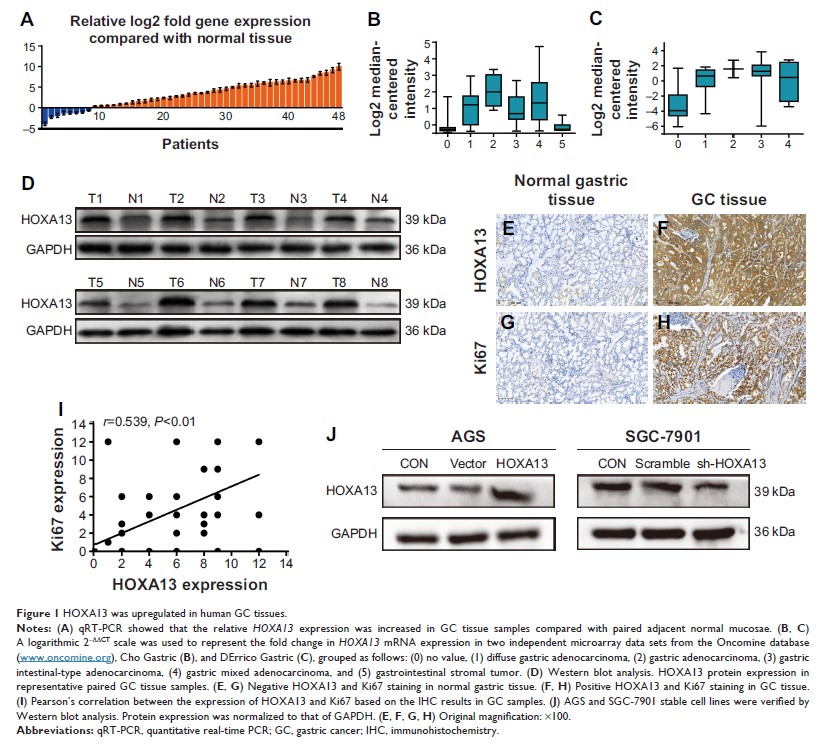108899
论文已发表
注册即可获取德孚的最新动态
IF 收录期刊
- 3.4 Breast Cancer (Dove Med Press)
- 3.2 Clin Epidemiol
- 2.6 Cancer Manag Res
- 2.9 Infect Drug Resist
- 3.7 Clin Interv Aging
- 5.1 Drug Des Dev Ther
- 3.1 Int J Chronic Obstr
- 6.6 Int J Nanomed
- 2.6 Int J Women's Health
- 2.9 Neuropsych Dis Treat
- 2.8 OncoTargets Ther
- 2.0 Patient Prefer Adher
- 2.2 Ther Clin Risk Manag
- 2.5 J Pain Res
- 3.0 Diabet Metab Synd Ob
- 3.2 Psychol Res Behav Ma
- 3.4 Nat Sci Sleep
- 1.8 Pharmgenomics Pers Med
- 2.0 Risk Manag Healthc Policy
- 4.1 J Inflamm Res
- 2.0 Int J Gen Med
- 3.4 J Hepatocell Carcinoma
- 3.0 J Asthma Allergy
- 2.2 Clin Cosmet Investig Dermatol
- 2.4 J Multidiscip Healthc

HOXA13 表达升高可通过激活 Erk1/2 促进胃癌的增殖和转移
Authors Qin Z, Chen Z, Weng J, Li S, Rong Z, Zhou C
Received 5 December 2018
Accepted for publication 24 January 2019
Published 4 March 2019 Volume 2019:12 Pages 1803—1813
DOI https://doi.org/10.2147/OTT.S196986
Checked for plagiarism Yes
Review by Single-blind
Peer reviewers approved by Dr Amy Norman
Peer reviewer comments 2
Editor who approved publication: Dr William Cho
Purpose: HOXA13 is a
transcription factor of the Homeobox (HOX ) gene family, which is highly evolutionarily
conserved. HOXA13 is
upregulated and associated with oncogenic properties in some cancers. Here, we
studied the potential mechanism of HOXA13 -mediated proliferation and metastasis in
gastric cancer (GC).
Methods: Quantitative
real-time PCR, Western blot, and immunohistochemistry were used to detect
HOXA13 expression levels in GC. In vitro and in vivo assays were performed to
investigate the function of HOXA13 in GC cell proliferation, migration,
and invasion. RNA-Seq transcriptome analysis was performed to study the
underlying mechanism of HOXA13 -mediated aggressiveness in GC.
Results: HOXA13
mRNA and protein expression levels were upregulated in GC tissues. According to
Cell Counting Kit-8 and colony formation assays, we found that HOXA13 overexpression
promoted proliferation. Flow cytometry analysis showed that HOXA13 overexpression
or knockdown led to G1-S phase transition or G1 phase arrest, respectively.
Western blot analysis results showed that HOXA13 overexpression increased cyclin
D1 expression, while knockdown decreased its expression. Wound healing and
transwell assay results demonstrated that HOXA13 overexpression
promoted the migration and invasion of GC cells. Western blot analysis results
also showed that HOXA13 overexpression upregulated N-cadherin and vimentin and
downregulated E-cadherin, while HOXA13 knockdown led to the opposite results,
indicating that HOXA13 might participate in epithelial to mesenchymal
transition. These results were verified in vivo by tumor xenograft and
metastasis assays. Mechanistically, using RNA-Seq transcriptome analysis, we
found that Erk1/2 activation played an important role in HOXA13 -induced GC
progression.
Conclusion: Our
results show that HOXA13 plays an important role in GC
development. HOXA13 overexpression promotes proliferation and
metastasis partly via activation of Erk1/2 in GC. Thus, HOXA13, together with
Erk1/2, may be promising targets for novel anticancer strategies.
Keywords: gastric
cancer, HOXA13 ,
Erk1, Erk2, proliferation, metastasis
